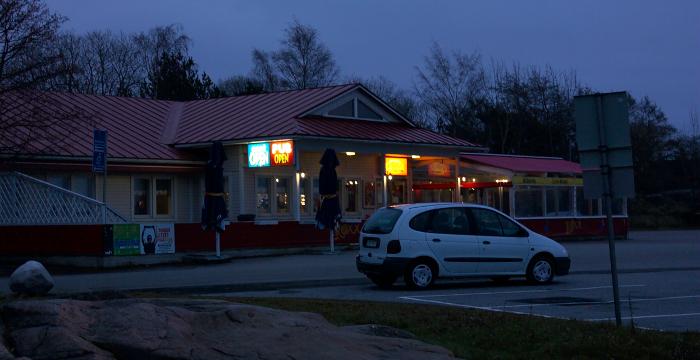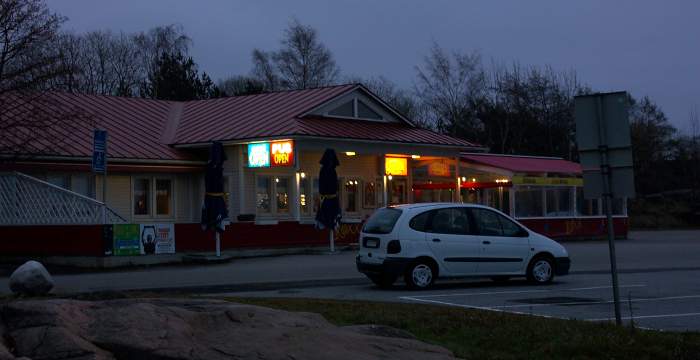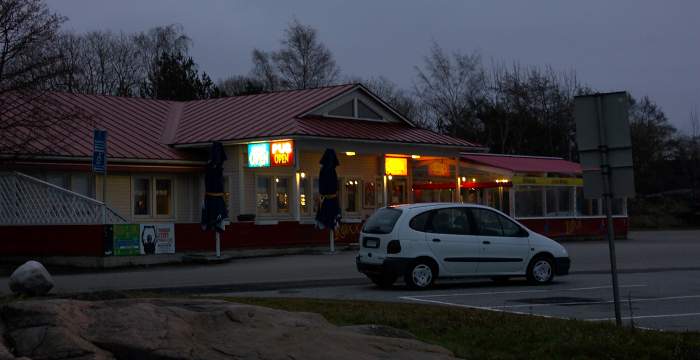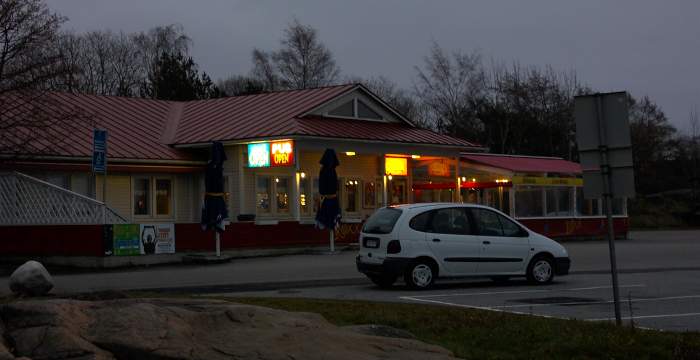| View previous topic :: View next topic |
| Author |
Message |
kansalliskala


Joined: 19 Jul 2007
Posts: 5044
Location: Southern Finland countryside
Expire: 2016-12-30
|
 Posted: Sun Nov 08, 2009 3:45 pm Post subject: How blue is blue Posted: Sun Nov 08, 2009 3:45 pm Post subject: How blue is blue |
 |
|
kansalliskala wrote:
Tried to capture the "blue moment". But which one is the right blue? Now I understand the neccessity to calibrate white balance on site sometimes.
4500

5500

6500

7500

EDIT: really bad jpeg compression on the last two .. file size only 32k though 
_________________
MF: Kodak DCS SLR/c; Samsung NX10; OM-10; Canon T50
Zuiko 28/3.5, Distagon 35/2.8; Yashica ML 50/2;
Zuiko 50/1.4; S-M-C 120/2.8; Zuiko 135/3.5; 200/5;
Tamron AD1 135/2.8, Soligor 180/3.5; Tamron AD1 300/5.6
Tamron zooms: 01A, Z-210
Yashicaflex C; Київ 4 + Юпитер 8, 11; Polaroid 100; Olympus XA; Yashica T3
Museum stuff: Certo-Phot; Tele-Edixon 135; Polaris 90-190; Asahi Bellows; Ixus IIs
Projects: Agfa Isolette III (no shutter), Canon AE-1D (no sensor),
Nikon D80 (dead), The "Peace Camera"
AF: Canon, Tokina, Sigma Video: JVC GZ-MG275E |
|
| Back to top |
|
 |
tobbsman


Joined: 25 Jul 2008
Posts: 2578
Location: Austria
|
 Posted: Sun Nov 08, 2009 4:11 pm Post subject: Posted: Sun Nov 08, 2009 4:11 pm Post subject: |
 |
|
tobbsman wrote:
6500 looks quite natural for my taste ...
Cheers
Tobias
_________________
Camera Pentax K10D, K20D, Super A
SMC K28 3.5, SMC K24 2.8, SMC K28/2, SMC K50/1.4,SMC A50/1.7, SMC M28/3.5, SMC A 50/1.7, SMC K135 2.5, SMC A50 1.2
SMC A35-105 3.5, SMC A70-210 4, SMC A20 2.8, SMC M28 2.8,K28/3.5 SMC A28 2.8, SMC A100 2.8 Macro, CZJ Flektogon 20 2.8 (MC), 35 2.4 (MC),S.M.C Takumar 85mm 1.8, Helios 44M-4, A.Schacht Travenar 90/2.8, C.Zeiss J. Sonnar 180/2.8
Check out my: 2012 New "Advanced Guide to Panorama Stiching" !
Check out my "Beginner's Guide to Panorama Stiching !
Visit my Asahi and Zeiss MF lens samples database ! |
|
| Back to top |
|
 |
Prometheus


Joined: 27 Feb 2008
Posts: 878
Location: Garphyttan, Sweden
|
 Posted: Sun Nov 08, 2009 4:35 pm Post subject: Posted: Sun Nov 08, 2009 4:35 pm Post subject: |
 |
|
Prometheus wrote:
If you want to portrait the feeling rather then documentation, then there is no right or correct one. I would go for: 4500 or 5500
_________________
Retrocamera.net |
|
| Back to top |
|
 |
Orio

Joined: 24 Feb 2007
Posts: 29545
Location: West Emilia
Expire: 2012-12-04
|
 Posted: Sun Nov 08, 2009 5:34 pm Post subject: Posted: Sun Nov 08, 2009 5:34 pm Post subject: |
 |
|
Orio wrote:
| Prometheus wrote: |
| If you want to portrait the feeling rather then documentation, then there is no right or correct one. |
+1
Also, what is correct? We know that colours don't really exist for the objects. They exist only for as much objects reflect a light source.
Light sources can be different, and they can also change in nature.
If we take the sunlight as "metering source", we limit the range of possibilities, but not by absolute terms. The sunlight at noon is different from the sunlight at dawn or at sundown.
If we decide that 5200 K (approx. sunlight value at noon) is our reference value, then we can act in two ways:
A- keep the 5200 K value all the time in the camera, and let the photos record the change in hues as the camera perceives it (which is not the same way as we perceive it, because our brains does balance the white a bit, but somehow similar)
B- constantly change the K value of the camera in order to approximate, at other times of the day, the same type of hue that you would have at noon.
This is the principle of white balancing, and it can produce results that are correct to the premise (make colours equal to sunlight at noon), but feel wrong to the human eye, because they do not correspond to what we perceive as humans, because our brain does balance the white also, but not as strongly as a camera white balance. The last two photos in the series are a good example of that feeling unnatural.
My way of doing is close to A : I keep 5200K value in the camera and use it for most of the day, except adjusting it a bit at dawn or sunset, to make it feel closer to the way our brain works.
_________________
Orio, Administrator
T*
NE CEDE MALIS AUDENTIOR ITO
Ferrania film is reborn! http://www.filmferrania.it/
Support the Ornano film chemicals company and help them survive!
http://forum.mflenses.com/ornano-chemical-products-t55525.html |
|
| Back to top |
|
 |
larsr


Joined: 25 Jun 2009
Posts: 272
Location: Helsinki, Finland
|
 Posted: Mon Nov 09, 2009 1:05 am Post subject: Posted: Mon Nov 09, 2009 1:05 am Post subject: |
 |
|
larsr wrote:
I'm also inclined to say there is no right or wrong blue moment color. Add to this the climate difference in Finland between summer and winter, and you have two different "blue moments" anyway (well, actually four, one for each season).
I like to think that photography isn't about a set or rules or standards, it's a medium for conveying feelings. beauty is in the eye of the beholder, as they say - and the photographer is his worst judge :)
_________________
Lars
Bodies:
DSLR: Nikon D200
SLR: Nikon FA, Pentax Spotmatic SPII, Zeiss Ikon Icarex 35TM
35mm: Voigtl�nder Vitoret
Nikkor MF
24/2.8K AI'd, 28/2.8 AIS, 35/2 AIS, 50/1.4 AIS, 50/1.8 AIS, 50/2 AI, 55/2.8 Micro, 35-70/3.5 AIS, 85/1.8K AI'd, 100/2.8 Series E, 105/2.5 AI, 105/2.5 AIS, 135/3.5 AI, Nikkor 180/2.8 ED AIS, 200/4-Q AI'd, 300/4.5-H AI'd
M42
Misc: Vivitar 28/2.5, Chinon 28/2.8, Cosina Auto Cosinon 50/1.8, Revue Auto Revuenon 50/1.8, Mamiya 50/2, Auto Flex 55/1.7, Cosina Cosinon 135/2.8 MC, Vivitar 135/2.8, Petri 200/3.5 CC Auto
Zeiss: Carl Zeiss (Ikon) Tessar 50/2.8, CZJ Tessar 50/2.8, CZJ Pancolar Electric 50/1.8 MC, CZJ Biotar 58/2 T, CZJ Sonnar MC S 135/3.5
Asahi-Pentax: SMC-Takumar 55/1.8, Super-Takumar 105/2.8, SMC-Takumar 135/3.5
USSR: Mir-1 37/2.8 (1958 GP), Helios 44-2 58/2
Pentacon/Meyer: Pentacon 29/2.8 MC, Pentacon 50/1.8 MC Electric, Meyer G�rlitz Oreston 50/1.8, Meyer G�rlitz Orestor 135/2.8, Pentacon 200/4
Nikkor AF
50/1.8 D, 60/2.8 Micro, 55-200/4-5.6 G VR, 70-300/4-5.6 ED, 18-70/3.5-4.5 G
Wantlist
Nikkor 105/1.8, Nikkor 135/2
|
|
| Back to top |
|
 |
PaulC


Joined: 23 Dec 2008
Posts: 2318
|
 Posted: Mon Nov 09, 2009 9:05 am Post subject: Posted: Mon Nov 09, 2009 9:05 am Post subject: |
 |
|
PaulC wrote:
You can't calibrate on site for this because it will turn your blue moment grey.
Perhaps it is better to think about this in terms of film rather than digital. If you were shooting film you would get your "blue moment" from a daylight WB recording medium, so if you want to replicate what people used to do with film then you need to use Orio's first method and set the WB for normal daylight.
_________________
View or buy my photos at:
http://shutterstock.com/g/paulcowan |
|
| Back to top |
|
 |
Arkku


Joined: 28 Feb 2007
Posts: 1416
Location: Helsinki, Finland
|
 Posted: Mon Nov 09, 2009 9:16 am Post subject: Posted: Mon Nov 09, 2009 9:16 am Post subject: |
 |
|
Arkku wrote:
I mostly agree with Orio's post above. I, too, prefer to approximate the “daylight balanced film” by erring towards 5200-5500K when in doubt, instead of trying to match the greys.
However, you could also combine multiple WB settings into the same photo. For example, the car probably appears quite white (not blue) in reality despite the blue moment, because you “know” that it's white, so you could blend the lower part from the 6500K with the sky from the 4500K. |
|
| Back to top |
|
 |
William


Joined: 26 Nov 2009
Posts: 489
Location: London
|
 Posted: Wed Jan 06, 2010 11:32 pm Post subject: Posted: Wed Jan 06, 2010 11:32 pm Post subject: |
 |
|
William wrote:
In the examples I would go somewhere between 5000 and 7000 although having not experienced the scene it's hard to know how blue it felt.
I shoot on AWB and when processing nearly always change the white balance but make sure to start doing this when the light is fresh in my mind. It is often initially quite out though. Orio's method sounds interesting though and I shall try it and agree that the WB of a scene is subjective. Emotional state changes things like sunlight feeling particularly vivid or coloured and it may be necessary to reflect this in the photo by not going entirely for accuracy. |
|
| Back to top |
|
 |
|
|
|
You cannot post new topics in this forum
You cannot reply to topics in this forum
You cannot edit your posts in this forum
You cannot delete your posts in this forum
You cannot vote in polls in this forum
|
